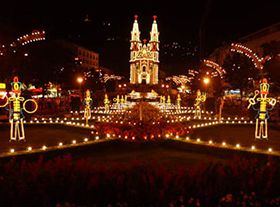Largo da Oliveira

Other
The Largo da Oliveira owes its name to a centuries-old olive-tree planted on this same site. Surrounded by picturesque houses that are typical of the north of Portugal, it is the ideal starting point for a walking tour of the city´s streets. But, in the square itself, there are also a number of interesting features: on the eastern side is a curious Gothic shrine, built in the reign of D. Afonso IV to commemorate the Battle of Salado, where the Portuguese and Castilian forces together defeated the Moorish army from Granada, in 1340.
Behind this is the Igreja de Nossa Senhora de Oliveira (or the Igreja da Colegiada - the Collegiate Church of Our Lady of the Olive-Tree), which is the first Gothic monument to have been built in the Minho, under the auspices of D. João I and in fulfilment of a vow that he made in return for victory against the Castilian army in the Battle of Aljubarrota (1385). The bell tower, which stands separate from the main body of the church, has evident Manueline features and was therefore built much later. Many distinguished figures were connected to the Colegiada de Nossa Senhora da Oliveira, such as Pedro Hispano, the doctor and philosopher who was elected Pope under the name of Pope John XXI. Inside the church´s elegant cloister is now housed the Museu Alberto Sampaio, with a remarkable collection of mediaeval and Renaissance silver pieces, most notably a sumptuous 14th-century silver altarpiece, unique in Portugal, and the tunic worn by D. João I at the Battle of Aljubarrota.
The main feature on the northern side of the square is the mediaeval building that once housed the town hall, surmounted by a stone sculpture that, according to tradition, represents Guimarães.
Beneath this, a Gothic arcade leads into the Largo de São Tiago, one of the most characteristic public spaces in the city.
You may also choose to leave the Largo da Oliveira by entering the spacious and harmonious square of Largo do Toural, setting off from here for a visit of the Museu Martins Sarmento, housed in the mediaeval cloisters of the Mosteiro de São Domingos, where you will find one of the most valuable collections of archaeological pieces, originating from Citânia de Briteiros, a fortified hilltop settlement some 10 kilometres from Guimarães, which provides clear evidence of life in Portugal during the Iron Age.




 Explore
Explore 
 Remember and Share
Remember and Share 


